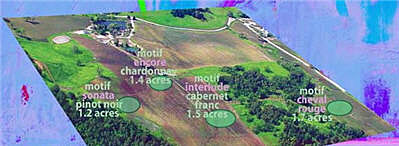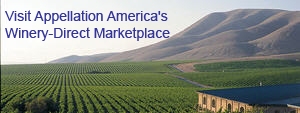

Gary Conway's depiction of Pinot Terroir shows the various elements, which when combined produce Carmody-McKnight's Pinot Noir.
Carmody-McKnight: Digging Deep into Terroir for a New Motif
Where Terroir is Inspiration
by
Laura Ness
September 8, 2008
 ack in the late 1960’s, well-known LA-based TV actor Gary Conway (Burke’s Law, Land of the Giants) decided he wanted a place in the country. The search led him to Paso Robles, where he hooked up with a realtor who decided to give him an aerial tour of some property. In the process, the helicopter crash-landed, giving Gary an unexpectedly up-close view of the land he was about to purchase. This close encounter led him to fall in love with this special property. He felt the land had been his savior, and you know what they say about how your soul belongs to the being who saves your life.
ack in the late 1960’s, well-known LA-based TV actor Gary Conway (Burke’s Law, Land of the Giants) decided he wanted a place in the country. The search led him to Paso Robles, where he hooked up with a realtor who decided to give him an aerial tour of some property. In the process, the helicopter crash-landed, giving Gary an unexpectedly up-close view of the land he was about to purchase. This close encounter led him to fall in love with this special property. He felt the land had been his savior, and you know what they say about how your soul belongs to the being who saves your life.
Shortly after, would-be cattle rancher, then farmer and eventually winery owner (as well as artist, actor, movie producer, neo-geologist and professed Jeffersonian), Conway planted vineyards on the far west side of Paso Robles. Having experimented with various crops and ranching ventures, he knew the soil was special. Just how special he didn’t realize at first. But when he started digging deeper, he discovered it had a great deal of limestone, like the finest vineyards of Burgundy. This led him to plant Pinot Noir and Chardonnay, both of which have flourished here in this relatively cool climate for over three decades, each year producing intensely flavored wines with an undeniably mineral backbone.
Knowing he had great soil wasn’t enough. Gary wanted to learn more, so he hired Tom Rice, local geology professor and soils expert from Cal Poly, to conduct a full study of

Gary Conway, Artist, Proprietor, Philosopher
The studies revealed that the soils at Carmody McKnight are weathered from calcareous and limestone rocks similar to those in the great vineyards of Domaine La Romanée Conti and La Tâche in France. Montmorillonite is the primary component of bentonite, which derives from volcanic ash. Its ability to bind water makes it a moisture-retention asset in dry climates. Limestone and montmorillonite are the two most important soil constituents in the renowned French vineyards, and are believed to contribute to wine greatness. Limestone contains significant levels of calcium carbonate which assures superb soil structure and porosity.
Dr. Rice’s curiosity about how vineyard soils might affect grape quality led to further investigation into the unique properties of the vineyard. The resources of Earth Information Technologies, John Deere Ag Sciences and Motorola were enlisted to tackle the challenges of understanding Carmody McKnight vineyard soil composition and precisely how this impacts grapes. In a single vineyard block, they found two distinctive soils: Calodo clay loam and Zaca clay. Calodo, prevalent in the Adelaida Hills, is decomposed from calcareous sandstone and shale and is known to be shallow and well-drained. Zaca, on the other hand, is deep and retains moisture.
Using the same block of Cabernet Sauvignon, it was shown over a 4-year period that vines in the upper area with shallow Calodo clay loam produce lower yields with higher Brix and higher pH, whereas the wetter Zaca clay soil at the bottom of the block produced grapes of lower Brix and lower pH. Says Conway, “The upper elevation tends to have more intense varietal flavor and character, but the lower elevations contribute unique complexity.”
Together, they combine to make nicely balanced wine: but they already knew that. Knowing more about each specific vineyard area and its unique soil types gave the inspiration for an extremely terroirist approach to winemaking on a microlevel.
View from the Sky Inspires a New Vision
Carmody McKnight Winemaker/Vineyardist, Greg Cropper, who formerly worked at nearby Justin Vineyards, poured over the research with great interest. When he viewed
Carmody McKnight Winemaker/Vineyardist, Greg Cropper
Says Gary, “The initial mapping and information that we derived from these unprecedented studies allowed us to dial in specific areas of the vineyard and make highly-educated viticultural decisions. We were able to take the GPS mapping and focus into specific soil attributes in a manner never before possible. We literally went into the vineyard and tagged sections that were oblong, round or rectangular, up to 1 acre each, as opposed to the common practice of selecting and harvesting from specific rows with vague, seat-of-the-pants opinions.”
The vision was to create wines that intensely represented the particular soils in which the vines were rooted. They also decided to throw some really good French oak at the program. This gave Greg the motivation to think completely outside the picking bin. And, it gave Gary just the excuse he needed to paint the beautiful new labels for what would become the Motif program.
The Soul of the Vineyard: The Soil As Master Canvas
When asked what specific soil types were isolated in making Motif wines, Greg and Gary replied, “The focus of Motif is to take advantage of these university studies and to draw upon particular soils and soil combinations in specific sections, especially in light of the fact that we have a myriad of soils even within just one small area (see the poster Pinot Terroir at top). Motif brings the search for terroir within practical reach and understanding. Encore Chardonnay encompasses Cropley Clay Loam as a key soil; Sonata Pinot Noir - Zaca Clay; Interlude Cabernet Franc - Nacimiento Loam; Cheval Rouge - Ayar Clay.” Gary notes that these wines are influenced not just by those soils but by the other rare soils that exist in this vineyard, especially the Calcium Montmorillonite.
Motif brings the search for terroir within practical reach and understanding. Encore Chardonnay encompasses Cropley Clay Loam as a key soil; Sonata Pinot Noir - Zaca Clay; Interlude Cabernet Franc - Nacimiento Loam; Cheval Rouge - Ayar Clay.” Gary notes that these wines are influenced not just by those soils but by the other rare soils that exist in this vineyard, especially the Calcium Montmorillonite.
Certainly the soils are as important to individual vine development as the foods one chooses to eat. And the way the vineyards are managed are as important as one’s exercise regimen, or lack thereof. Asked how the Motif vineyards are managed differently, Gary notes, “The Motif wines derive from vineyards within a vineyard. The world's renowned vineyards tend to be small, and in some part, the smaller size allows mastery over the vineyard, understanding and taking advantage of unique terroir. Highly refined fruit thinning and leaf pulling for maximum sun exposure are routine in the Motif sections. In addition, the Encore Chardonnay consists entirely of free run. The red wines are crushed into s










 READER FEEDBACK: To post your comments on this story,
READER FEEDBACK: To post your comments on this story,



